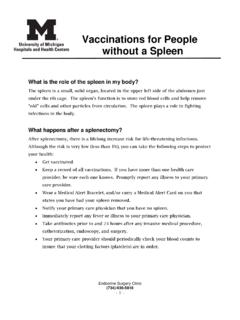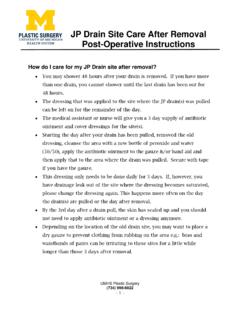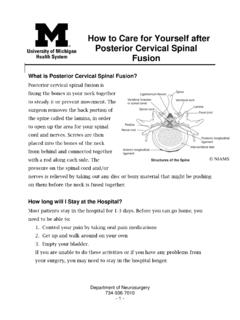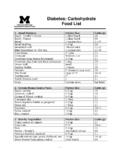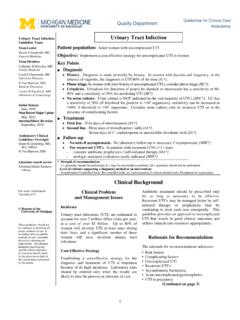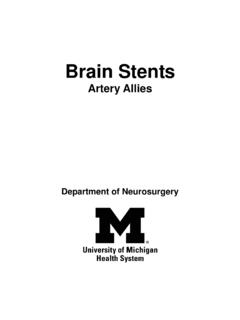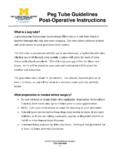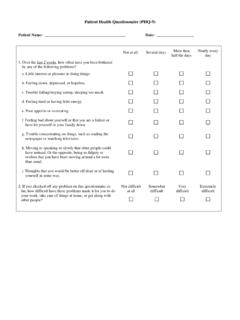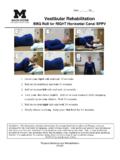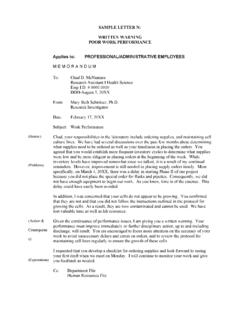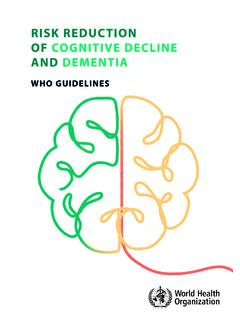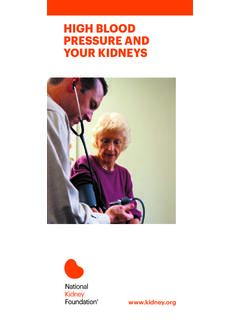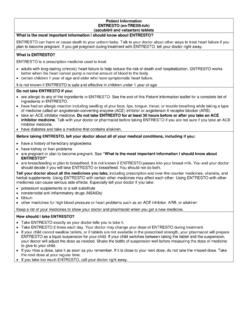Transcription of Chronic Kidney Management of Chronic Kidney Disease
1 Guidelines for Clinical Care Quality Department Ambulatory Chronic Kidney Disease Guideline Management of Chronic Kidney Disease Team Team Leader Patient population: Adults with Chronic Kidney Disease (CKD). Jennifer Reilly Lukela, MD Objectives: General Medicine 1. Identify populations that may benefit from more systematic screening for CKD and provide an Team Members overview of methods for screening and diagnosis. R. Van Harrison, PhD. Medical Education 2. Outline treatment options for patients with CKD to decrease progression of renal deterioration and Masahito Jimbo, MD. potentially decrease morbidity and mortality. Family Medicine 3. Highlight common co-morbid conditions such as cardiovascular Disease and diabetes, emphasizing Ahmad Mahallati, MD the importance of aggressive Management of these conditions to potentially decrease morbidity and Nephrology mortality among patients with CKD.
2 Rajiv Saran, MBBS Key points Nephrology Annie Z. Sy, PharmD. Background Quality Management Despite increasing prevalence of CKD, it is often under-recognized and under-treated. [A]*. Program Evidence for screening and Management of early stage CKD is limited due to absence of large randomized controlled trials. Initial Release: Definition and Staging (Tables 1 and 2). November, 2013 Kidney damage for > 3 months, defined by structural or functional abnormalities of the Kidney , with Interim/Minor Revision: or without decreased GFR. March, 2014. June, 2016 Diagnosis Screen patients with diabetes annually for microalbuminuria if not on an ACE inhibitor or ARB and for creatinine and estimated glomerular filtration rate [IA]. Consider screening for CKD among Ambulatory Clinical patients at increased risk, especially those with hypertension [IA] and patients aged > 55 years.
3 [IID]. Guidelines Oversight Grant Greenberg, MD, Laboratory studies needed to diagnose and stage CKD include an assessment of glomerular filtration MA, MHSA rate (GFR) (usually estimated by the MDRD equation) and urine studies for the presence or absence R. Van Harrison, PhD of albuminuria. [IC]. Ultrasound imaging for structural Kidney Disease may also be helpful in certain populations. [IID]. Treatment Literature search service Taubman Health Sciences Blockade of the renin angiotensin aldosterone system with either an angiotensin converting enzyme Library inhibitor (ACEI) or an angiotensin receptor blocker (ARB) is the cornerstone of treatment to prevent or decrease the rate of progression to end stage renal Disease . [IA]. Blood pressure control (< 140/90) reduces renal Disease progression and cardiovascular morbidity and mortality.
4 Current evidence does not support stricter blood pressure control targets for the For more information: majority of patients with CKD [IA]. CKD patients with albuminuria may benefit from tighter 734-936-9771 control with a target of < 130/80 [IIA]. Optimally manage comorbid diabetes and address cardiovascular risk factors to decrease risk for cardiovascular Disease the leading cause of mortality for patients with CKD. [IA] Statin or Regents of the statin/ezetimibe therapy is recommended in all CKD patients age 50 years to decrease the risk of University of Michigan cardiovascular or atherosclerotic events. [IA]. Monitor for other common complications of CKD including: anemia, electrolyte abnormalities, abnormal fluid balance, mineral bone Disease , and malnutrition.
5 [ID]. These guidelines should not Avoid nephrotoxic medications to prevent worsening renal function. [ID]. be construed as including all Monitoring and Follow Up proper methods of care or excluding other acceptable The timing and frequency of CKD monitoring and follow up depends on Disease severity and risk for methods of care reasonably directed to obtaining the same progression; GFR and albuminuria should be assessed a minimum of once per year. [ID] (table 16). results. The ultimate Refer CKD stage G4 or G5 (see Table 2) to nephrology for co- Management and preparation for renal judgment regarding any specific clinical procedure or replacement therapy. Consider referral at earlier stage to assist with diagnosis of underlying cause treatment must be made by and/or treatment of common complications of CKD.
6 [IC]. the physician in light of the circumstances presented by * Strength of recommendation: the patient. I= generally should be performed; II = may be reasonable to perform; III = generally should not be performed. Levels of evidence for the most significant recommendations A = randomized controlled trials; B=controlled trials, no randomization; C=observational studies; D=opinion of expert panel 1 UMHS Chronic Kidney Disease Guideline, March 2014. Table 1. Definition of CKD Table 2. Staging of CKD. CKD is classified by the CGA system: Cause, GFR category, Albuminuria category Abnormalities of Kidney structure or function (defined by markers of Kidney injury or decreased GFR) present GFR GFR Terms for > 3 months with implications for health. (Either Categories (ml/min/.))
7 Criterion is sufficient for diagnosis.) m2). 1. Markers of Kidney damage (one or more): G1 > 90 Normal or high Albuminuria (AER 30mg/24hrs; ACR G2 60-89 Mildly decreased 30mg/g) G3a 45-59 Mildly to moderately Urine sediment abnormalities decreased Electrolyte and other abnormalities due to G3b 30-44 Moderately to severely tubular disorders decreased Abnormalities detected by histology G4 15-29 Severely decreased Structural abnormalities detected by imaging G5 < 15 Kidney failure History of prior Kidney transplantation Albuminuria AER ACR Terms 2. GFR < 60 mL/ Categories (mg/24hrs) (mg/g). A1 < 30 < 30 Normal to * GFR = glomerular filtration rate; AER = albumin excretion rate; ACR = albumin-to-creatinine ratio mildly increased A2 30-300 30-300 Moderately Modified from KDOQI Clinical Practice Guidelines for the increased Evaluation and Management of Chronic Kidney Disease : A3 > 300 > 300 Severely (2013) increased AER = albumin excretion rate ACR = albumin-to-creatinine ratio Table 3.
8 Common Risk Factors for the Table 4. Common Causes of Acute or Acute on Development of CKD Chronic Kidney Injury Diabetes Volume depletion Hypertension Acute urinary obstruction Age > 55 years Use of diuretics, ACE or ARB. Family history of Kidney Disease Use of NSAID, iodinated contrast agents, or other Obesity or metabolic syndrome nephrotoxic agents Heart failure Acute glomerulonephritis or acute intestinal nephritis Liver failure Malignancy ( , myeloma). Table 5. Key Aspects of the Medical History Table 6. Commonly Used Equations in Evaluating Patients with CKD to Estimate GFR (eGFR). Prior Kidney Disease or dialysis MDRD (Modification in Diet and Renal Disease Study) 4- Incidental albuminuria or hematuria (microscopic or variable equation gross) in the past GFR (mL/ m2) = 186 x (SCr) x (Age) x ( Urinary symptoms such as nocturia, frequency, polyuria, if female) x ( if African-American).
9 Urgency, hesitancy; a history of foamy/frothy urine CKD-EPI (Epidemiology Collaboration) equation may indicate prior heavy proteinuria History of nephrolithiasis GFR = 141 X min(SCr/ ,1) X max(SCr/ ,1) X X. Family history of Kidney Disease [if female] X [if black]. Diseases that share risk factors with CKD: DM, HTN, Patient weight is not required for eGFR using either equation. Results are CAD, PAD, heart failure normalized to body surface area - BSA (accepted average adult surface area). Equations tend to underestimate GFR if large body surface Systemic diseases that might affect Kidney ( , area ( , obese or large, muscular) patients and overestimate GFR in rheumatologic diseases, especially SLE, Sjogren's, small body surface area patients. Both equations should be used with Progressive Systemic Sclerosis) caution when assessing GFR in those with extremes of body habitus or History of use of medications that might affect renal muscle mass, during pregnancy, and in the elderly.
10 Function: OTC (especially NSAIDs and herbal Online CKD EPI & MDRD GFR Calculator (with SI Units): medications) or prescription ( , lithium, calcineurin inhibitors). 2 UMHS Chronic Kidney Disease Guideline, March 2014. Table 7. Common Agents for Renin angiotensin Aldosterone Blockade Dosage Range Dose Adjustments Based on Generic for Normal GFR (mL/min) Cost 30 days Comments (Brand) Name Kidney (Percentage of Usual Dosage) Generic Function 30-59 10-29 < 10 Brand angiotensin converting Enzyme Inhibitors (ACE-I). Benazepril 10 - 40 mg/day 75% 50% 25% $3-6 Can cause acute increase in SCr (Lotensin) (divided q12-24h) $62 and/or potassium; continue Enalapril 5 - 40 mg/day 50-100% 50% 25% $4-6 medication if increase is < 30%;. (Vasotec) (divided q12-24h) $152-239 monitor renal function and Captopril 25 - 50 mg q8-12h 75% 50-75% 50% $25-42 potassium levels with initiation (Capoten) $41-106 and with each dosage change, Ramipril - 20 mg/day 50% 25-50% 25% $8-17 every 1-2 weeks until values (Altace) (divided q12-24h) $99-127 return to baseline (usually within Fosinopril 10 - 40 mg/day - - 75-100% $8 4-6 weeks).
